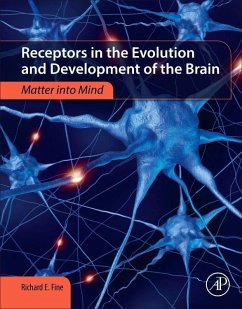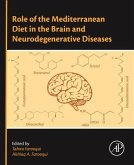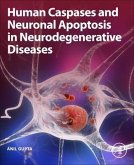- Broschiertes Buch
- Merkliste
- Auf die Merkliste
- Bewerten Bewerten
- Teilen
- Produkt teilen
- Produkterinnerung
- Produkterinnerung
Receptors in the Evolution and Development of the Brain: Matter into Mind presents the key role of receptors and their cognate ligands in wiring the mammalian brain from an evolutionary developmental biology perspective. It examines receptor function in the evolution and development of the nervous system in the large vertebrate brain, and discusses rapid eye movement sleep and apoptosis as mechanisms to destroy miswired neurons. Possible links between trophic deficits and connectional diseases including Alzheimer's, Parkinson's, and ALS are also discussed. This book is extremely useful to…mehr
Andere Kunden interessierten sich auch für
![Oxidative Stress and Dietary Antioxidants in Neurological Diseases Oxidative Stress and Dietary Antioxidants in Neurological Diseases]() Oxidative Stress and Dietary Antioxidants in Neurological Diseases218,99 €
Oxidative Stress and Dietary Antioxidants in Neurological Diseases218,99 €![Role of the Mediterranean Diet in the Brain and Neurodegenerative Diseases Role of the Mediterranean Diet in the Brain and Neurodegenerative Diseases]() Role of the Mediterranean Diet in the Brain and Neurodegenerative Diseases164,99 €
Role of the Mediterranean Diet in the Brain and Neurodegenerative Diseases164,99 €![World of Neurons World of Neurons]() Hoda AshryWorld of Neurons46,99 €
Hoda AshryWorld of Neurons46,99 €![Neuronal Chloride Transporters in Health and Disease Neuronal Chloride Transporters in Health and Disease]() Neuronal Chloride Transporters in Health and Disease218,99 €
Neuronal Chloride Transporters in Health and Disease218,99 €![The Immune System and Mental Health The Immune System and Mental Health]() Hymie AnismanThe Immune System and Mental Health164,99 €
Hymie AnismanThe Immune System and Mental Health164,99 €![Neuroinflammation, Resolution, and Neuroprotection in the Brain Neuroinflammation, Resolution, and Neuroprotection in the Brain]() Akhlaq A. FarooquiNeuroinflammation, Resolution, and Neuroprotection in the Brain163,99 €
Akhlaq A. FarooquiNeuroinflammation, Resolution, and Neuroprotection in the Brain163,99 €![Human Caspases and Neuronal Apoptosis in Neurodegenerative Diseases Human Caspases and Neuronal Apoptosis in Neurodegenerative Diseases]() Anil GuptaHuman Caspases and Neuronal Apoptosis in Neurodegenerative Diseases49,99 €
Anil GuptaHuman Caspases and Neuronal Apoptosis in Neurodegenerative Diseases49,99 €-
-
-
Receptors in the Evolution and Development of the Brain: Matter into Mind presents the key role of receptors and their cognate ligands in wiring the mammalian brain from an evolutionary developmental biology perspective. It examines receptor function in the evolution and development of the nervous system in the large vertebrate brain, and discusses rapid eye movement sleep and apoptosis as mechanisms to destroy miswired neurons. Possible links between trophic deficits and connectional diseases including Alzheimer's, Parkinson's, and ALS are also discussed. This book is extremely useful to those with an interest in the molecular and cellular neurosciences, including those in cognitive and clinical branches of this subject, and anyone interested in how the incredibly complex human brain can build itself.
Hinweis: Dieser Artikel kann nur an eine deutsche Lieferadresse ausgeliefert werden.
Hinweis: Dieser Artikel kann nur an eine deutsche Lieferadresse ausgeliefert werden.
Produktdetails
- Produktdetails
- Verlag: Academic Press / Elsevier Science & Technology
- Artikelnr. des Verlages: C2016-0-00013-X
- Seitenzahl: 282
- Erscheinungstermin: 18. Juni 2019
- Englisch
- Abmessung: 231mm x 191mm x 15mm
- Gewicht: 570g
- ISBN-13: 9780128110126
- ISBN-10: 0128110120
- Artikelnr.: 55875145
- Herstellerkennzeichnung
- Libri GmbH
- Europaallee 1
- 36244 Bad Hersfeld
- gpsr@libri.de
- Verlag: Academic Press / Elsevier Science & Technology
- Artikelnr. des Verlages: C2016-0-00013-X
- Seitenzahl: 282
- Erscheinungstermin: 18. Juni 2019
- Englisch
- Abmessung: 231mm x 191mm x 15mm
- Gewicht: 570g
- ISBN-13: 9780128110126
- ISBN-10: 0128110120
- Artikelnr.: 55875145
- Herstellerkennzeichnung
- Libri GmbH
- Europaallee 1
- 36244 Bad Hersfeld
- gpsr@libri.de
Dr. Richard E. Fine received his Bachelor's and PhD degrees in Biochemistry from University of California at Berkeley and Brandeis University respectively. He then was a postdoctoral fellow in the laboratory of Francis Crick and Sydney Brenner at the Laboratory of Molecular Biology in Cambridge, U.K. During this period he and his colleague, Dennis Bray provided the first evidence for actin in growing neurons. Dr. Fine became an Assistant Professor of Physiology and Biochemistry at Boston University School of Medicine and demonstrated the existence of actin regulatory molecules, tropomyosin and troponin C in growing neurons, and he subsequently became interested in the role of clathrin coated vesicles in endocytic and exocytic processes in neurons and in other tissues. He also isolated and characterized vasopressin receptors, demonstrated for the first time that a large molecular, transferrin, can cross the blood brain barrier. Our lab in collaboration with Dr. Ken Kosik were the first to show that an antisense oligonucleotide can be used in vivo to block the synthesis of a single protein. Using the rabbit retina we were able to show that an antisense nucleotide against the kinesin mRNA can block the critical role of kinesin in the transport of synaptic vesicles, neuropeptide containing vesicles and vesicles destined for the plasma membrane. In recent years Dr. Fine's laboratory has focused on the role of the amyloid beta peptide in Alzheimer's disease especially in brain capillary endothelium. Also he has recently focused on the role of a mutant protein VPS35, a component of the retromer in Parkinson's and Alzheimer's diseases. During his career he has received over $25,000,000 in grant funding, have served on both NIH and VA review panels and authored or co-authored over 100 research papers.
1. Classes of Receptors, Their Signaling Pathways and Their Synthesis and Transport2. The RNA World and Roles of Receptors and Their Cognate Ligands in Archaea, Bacteria and Choanoflagellates; the latter being the Ancestor of all Eukaryotes3. Dictyostelium Discoideum: Role of Receptors in Differentiation. Sponges are Among the Earliest Multicellular Animals while Comb Jellies are Thought to be Closest to the Ancestral Nerve Cell Containing Animal. Hydras are Among the Earliest Animals with a True Nervous System4. The Growth Cone; the Key Organelle in the Steering of the Neuronal Processes; The Synapse; Role in Neurotransmitter Release5. Neuronal Cell Biology6. Glial Cells; The Evolution of the Myelinated Axon; Blood Brain Barrier (BBB)7. A Testable Theory to Explain How the Wiring of the Brain Occurs8. The Development of the Cerebral Cortex9. The Importance of Rapid Eye Movement (REM) Sleep and Other Forms of Sleep in Selecting the Appropriate Neuronal Circuitry; Programmed Cell Death/Apoptosis10. The Key Roles of BDNF and Endocannabinoids at Various Stages of Brain Development Including Neuronal Commitment, Migration and Synaptogenesis11. The Key Roles of Axon and Dendrite Guidance Molecules and the Extracellular Matrix in All Stages of Brain Development12. Key Receptors involved in Laminar and Terminal Specification and Synapse Construction13. Steroid Hormones and their Receptors are Key to Sexual Differentiation of the Brain while Glucocorticoids and their Receptors are Key Components of Brain Development and Stress Tolerance; The Hypothalamic Hormone Producing Cells: Importance in Various Functions During and After Brain Development14. The Roles of Receptors and Trophic Factors in the Development of the Enteric Nervous System (ENT) and in the Connections between Viruses, the Microbiota, (ENT) and Brain15. Synaptic Pruning During Development and Throughout Life Depends on Trophic Factor Interactions: The Corollary Described in Chapter 14, Postulating the Quantization of Trophic Factor Requirements, Provides a Plausible Explanation for the Survival of Neurons Partially Deprived of their Full Complement of Trophic Factors16. Receptor Mediated Mechanisms for Drugs of Abuse which may Adversely Affect Brain Development17. Role of Trophic Factors and Receptors in Developmental Brain Disorders18. Trophic Factor-Receptor Interactions which Mediate Neuronal Survival can in Some Cases Last Through Life, and Trophic Deficits can Produce Connectional Neurodegenerative Diseases 19. Potential Use of Neuronal Stem Cells to Replace Dying Neurons Depends on Trophic Factors and Receptors20. The Key Roles of Axon and Dendrite Guidance Molecules and the Extracellular Matrix in All Stages of Brain Development
1. Classes of Receptors, Their Signaling Pathways and Their Synthesis and Transport2. The RNA World and Roles of Receptors and Their Cognate Ligands in Archaea, Bacteria and Choanoflagellates; the latter being the Ancestor of all Eukaryotes3. Dictyostelium Discoideum: Role of Receptors in Differentiation. Sponges are Among the Earliest Multicellular Animals while Comb Jellies are Thought to be Closest to the Ancestral Nerve Cell Containing Animal. Hydras are Among the Earliest Animals with a True Nervous System4. The Growth Cone; the Key Organelle in the Steering of the Neuronal Processes; The Synapse; Role in Neurotransmitter Release5. Neuronal Cell Biology6. Glial Cells; The Evolution of the Myelinated Axon; Blood Brain Barrier (BBB)7. A Testable Theory to Explain How the Wiring of the Brain Occurs8. The Development of the Cerebral Cortex9. The Importance of Rapid Eye Movement (REM) Sleep and Other Forms of Sleep in Selecting the Appropriate Neuronal Circuitry; Programmed Cell Death/Apoptosis10. The Key Roles of BDNF and Endocannabinoids at Various Stages of Brain Development Including Neuronal Commitment, Migration and Synaptogenesis11. The Key Roles of Axon and Dendrite Guidance Molecules and the Extracellular Matrix in All Stages of Brain Development12. Key Receptors involved in Laminar and Terminal Specification and Synapse Construction13. Steroid Hormones and their Receptors are Key to Sexual Differentiation of the Brain while Glucocorticoids and their Receptors are Key Components of Brain Development and Stress Tolerance; The Hypothalamic Hormone Producing Cells: Importance in Various Functions During and After Brain Development14. The Roles of Receptors and Trophic Factors in the Development of the Enteric Nervous System (ENT) and in the Connections between Viruses, the Microbiota, (ENT) and Brain15. Synaptic Pruning During Development and Throughout Life Depends on Trophic Factor Interactions: The Corollary Described in Chapter 14, Postulating the Quantization of Trophic Factor Requirements, Provides a Plausible Explanation for the Survival of Neurons Partially Deprived of their Full Complement of Trophic Factors16. Receptor Mediated Mechanisms for Drugs of Abuse which may Adversely Affect Brain Development17. Role of Trophic Factors and Receptors in Developmental Brain Disorders18. Trophic Factor-Receptor Interactions which Mediate Neuronal Survival can in Some Cases Last Through Life, and Trophic Deficits can Produce Connectional Neurodegenerative Diseases 19. Potential Use of Neuronal Stem Cells to Replace Dying Neurons Depends on Trophic Factors and Receptors20. The Key Roles of Axon and Dendrite Guidance Molecules and the Extracellular Matrix in All Stages of Brain Development








